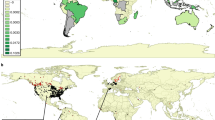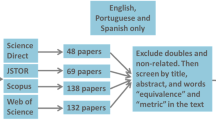Abstract
Biodiversity offsets seek to compensate for residual environmental impacts of planned developments after appropriate steps have been taken to avoid, minimize or restore impacts on site. Offsets are emerging as an increasingly employed mechanism for achieving net environmental benefits, with offset policies being advanced in a wide range of countries (i.e., United States, Australia, Brazil, Colombia, and South Africa). To support policy development for biodiversity offsets, we review a set of major offset policy frameworks—US wetlands mitigation, US conservation banking, EU Natura 2000, Australian offset policies in New South Wales, Victoria, and Western Australia, and Brazilian industrial and forest offsets. We compare how the frameworks define offset policy goals, approach the mitigation process, and address six key issues for implementing offsets: (1) equivalence of project impacts with offset gains; (2) location of the offset relative to the impact site; (3) “additionality” (a new contribution to conservation) and acceptable types of offsets; (4) timing of project impacts versus offset benefits; (5) offset duration and compliance; and (6) “currency” and mitigation replacement ratios. We find substantial policy commonalities that may serve as a sound basis for future development of biodiversity offsets policy. We also identify issues requiring further policy guidance, including how best to: (1) ensure conformance with the mitigation hierarchy; (2) identify the most environmentally preferable offsets within a landscape context; and (3) determine appropriate mitigation replacement ratios.
Similar content being viewed by others
References
Ambrose RF (2000) Wetland mitigation in the United States: assessing the success of mitigation policies. Wetlands (Australia) 19:1–27
Ball IR, Possingham HP (2000) MARXAN (V1.8.2): Marine Reserve Design Using Spatially Explicit Annealing, a Manual
Bartoldus CC (1999) A comprehensive review of wetland assessment procedures: a guide for wetland practioners. Environmental Concern, Inc., St. Michaels, MD, 196 pp
(Brazil Fed. Law 4771, Provisional Measures 2166/67) Forestry Code, Brazil Federal Law 4771 (1965) Provisional Measures 2166/67 (2001)
(Brazil Fed. Law 9985, Decree 4340) Protected Areas Law, Brazil Federal Law 9985 (2000) Decree 4340 (2002)
Burgin S (2008) BioBanking: an environmental scientist’s view of the role of biodiversity banking offsets in conservation. Biodiversity and Conservation 17:807–816
Council of the European Communities (1979) Council Directive 79/409/EEC of 2 April 1979 on the Conservation of Wild Birds
Council of the European Communities (1992) Council Directive 92/43/EEC of 21 May 1992 on the Conservation of Natural Habitats and of Wild Fauna and Flora
Environmental Law Institute (2002) Banks and fees: the status of off-site wetland mitigation in the United States. Washington, DC, 202 pp
European Commission (2000) Managing Natura 2000 sites: the provisions of Article 6 of the Habitats Directive 92/43/EEC
European Commission (2001) Assessment of plans and projects significantly affecting Natura 2000 sites: methodological guidance on the provisions of Article 6(3) and (4) of the Habitats Directive 92/43/EEC
Gibbons P, Lindenmayer DB (2007) Offsets for land clearing: no net loss or the tail wagging the dog? Ecological Management & Restoration 8:26–31
International Energy Agency (2007) World energy outlook 2007. Paris, France
Kiesecker JM, Copeland H, Pocewicz A, McKenney B (2009a) Development by design: blending landscape level planning with the mitigation hierarchy. Frontiers in Ecology and the Environment. doi:10.1890/090005
Kiesecker JM, Copeland H, Pocewicz A, Nibbelink N, McKenney B, Dahlke J, Holloran M, Stroud D (2009b) A framework for implementing biodiversity offsets: selecting sites and determining scale. BioScience 59:77–84
Margules CR, Pressey RL (2000) Systematic conservation planning. Nature 405:243–253
McAllister LS, Peniston BE, Leibowitz SG, Abbruzzese B, Hyman JB (2000) A synoptic assessment for prioritizing wetland restoration efforts to optimize flood attenuation. Wetlands 20:70–83
Moilanen A, van Teeffelen A, Ben-Haim Y, Ferrier S (2008) How much compensation is enough? A framework for incorporating uncertainty and time discounting when calculating offset ratios for impacted habitat. Restoration Ecology 17:470–478
National Research Council (2001) Compensating for wetland losses under the Clean Water Act. National Academy Press, Washington, DC, 348 pp
Noss RF, Carroll C, Vance-Borland K, Wuerthner G (2002) A multicriteria assessment of the irreplaceability and vulnerability of sites in the greater Yellowstone ecosystem. Conservation Biology 16:895–908
New South Wales Department of Environment and Climate Change (NSW DECC) (2007) BioBanking biodiversity banking and offsets scheme: scheme overview. Sydney, Australia
New South Wales Department of Environment and Climate Change (NSW DECC) (2008) BioBanking assessment methodology. Sydney, Australia
New South Wales Department of Natural Resources (NSW DNR) (2005) Native vegetation regulation 2005: environmental outcomes assessment methodology. Sydney, Australia
Parkes D, Newell G, Cheal D (2003) Assessing the quality of native vegetation: the ‘habitat hectares’ approach. Ecological Management & Restoration 4:S29–S38
Pressey RL, Bottrill MC (2008) Opportunism, threats, and the evolution of systematic conservation planning. Conservation Biology 22:1340–1345
Race MS, Fonseca MS (1996) Fixing compensatory mitigation: what will it take? Ecological Applications 6:94–101
The Resources Agency & California Environmental Protection Agency (1995) Official Policy on Conservation Banks
Rio Tinto (2004) Rio Tinto’s biodiversity strategy. London, UK and Melbourne, Australia, 12 pp
ten Kate K, Bishop J, Bayon R (2004) Biodiversity offsets: views, experience, and the business case. IUCN, Gland, Switzerland and Cambridge, UK, and Insight Investment, London, UK, 95 pp
US Army Corps of Engineers (2002) Regulatory Guidance Letter No. 02-2
US Army Corps of Engineers, Environmental Protection Agency, Natural Resources Conservation Service, Fish and Wildlife Service, National Oceanic and Atmospheric Administration (1995) Federal guidance for the establishment, use and operation of mitigation banks. 60 US Federal Register 58605-58614
US Army Corps of Engineers, Environmental Protection Agency, Fish and Wildlife Service, National Oceanic and Atmospheric Administration (2000) Federal guidance on the use of in-lieu fee arrangements for the compensatory mitigation under Section 404 of the Clean Water Act and Section 10 of the Rivers and Harbors Act. 65 US Federal Register 66914-17
US Department of the Interior (US DOI) (2003) Guidance for the establishment, use and operation of Conservation Banks
US Environmental Protection Agency & US Department of the Army (US EPA and DA) (1990) Memorandum of agreement between the Environmental Protection Agency and the Department of the Army concerning the determination of mitigation under the Clean Water Act Section 404(b)(1) guidelines
US Fish, Wildlife Service (US FWS) (2006) Conservation banking: incentives for stewardship. US Fish and Wildlife Service Endangered Species Program. Arlington, VA
Victoria Department of Natural Resource and Environment (Victoria DNRE) (2002) Victoria’s native vegetation management – a framework for action
Victoria Department of Sustainability and the Environment (Victoria DSE) (2008) Native vegetation offsets – VPP practice note
Vitousek PM, Mooney HA, Lubchenco J, Melillo JM (1997) Human domination of earth’s ecosystems. Science 277:494–499
Western Australia Environmental Protection Agency (2006) Environmental offsets: position statement no. 9
World Bank (2006) Global economic prospects 2007: managing the next wave of globalization. Washington, DC, 208 pp
Acknowledgments
We thank the Class of ‘55 Social Venture Fund, De Norske Veritas, and The Nature Conservancy for support in funding this study. We also thank Ted Gullison, Art Blundell, Tormod Burkey and Jared Hardner for their thoughtful comments.
Author information
Authors and Affiliations
Corresponding author
Rights and permissions
About this article
Cite this article
McKenney, B.A., Kiesecker, J.M. Policy Development for Biodiversity Offsets: A Review of Offset Frameworks. Environmental Management 45, 165–176 (2010). https://doi.org/10.1007/s00267-009-9396-3
Received:
Accepted:
Published:
Issue Date:
DOI: https://doi.org/10.1007/s00267-009-9396-3




